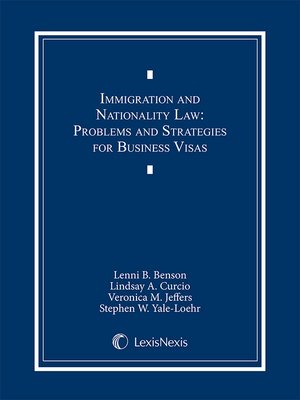Immigration and Nationality Law
ebook ∣ Chapter 3 and 4: Problems and Strategies for Business Visas
By Lenni B. Benson

Sign up to save your library
With an OverDrive account, you can save your favorite libraries for at-a-glance information about availability. Find out more about OverDrive accounts.
Find this title in Libby, the library reading app by OverDrive.



Search for a digital library with this title
Title found at these libraries:
| Loading... |
This smaller slice of Chapters 3 and 4 of Immigration and Nationality Law: Problems and Strategies introduces the reader to the legal concepts and experience of practicing immigration law. Chapter 3 explores all nonimmigrant visa classifications, with a strong focus on employment-based categories. It first provides an overview of the various nonimmigrant visa categories. It includes a variety of hypothetical problems. The chapter also discusses issues with maintaining or changing nonimmigrant status, benching, and severance. The chapter then discusses temporary visa options that make it easier or harder to transition to green card status. This comprehensive review of all nonimmigrant visa categories provides the reader with an understanding of how the categories relate throughout the immigration process and how to analyze for all possible nonimmigrant categories for which an individual may qualify. Chapter 4 discusses immigrant visa categories, with an emphasis on the employment-related green card categories. It discusses the family-related immigrant visa categories through various hypotheticals analyzing marriage-based cases, the various definitions of children in the statute, family relationships pertaining to preference categories and all criteria. The chapter then turns to the employment-related preference categories. The chapter uses problem sets to discuss all five employment-based preference categories and complex topics such as the labor certification process, availability of visa numbers and wait times, classifications not requiring labor certification such as the national interest waiver, and cross-chargeability. The chapter concludes by using hypotheticals to discuss adjustment of status and consular processing issues to provide the reader with an understanding when each is appropriate. Together, these two chapters provide an ideal overview for an immigration law class focusing on business immigration issues. They are also valuable for training new paralegals and attorneys or for those attorneys contemplating a change in practice area. For those practitioners interested in the answers for the hypotheticals and questions raised in the text, please contact us.






